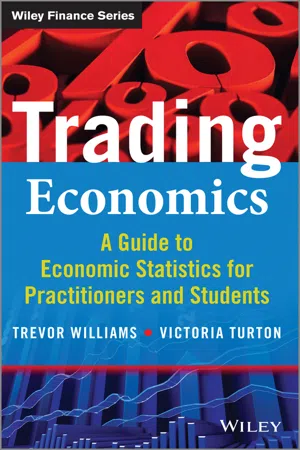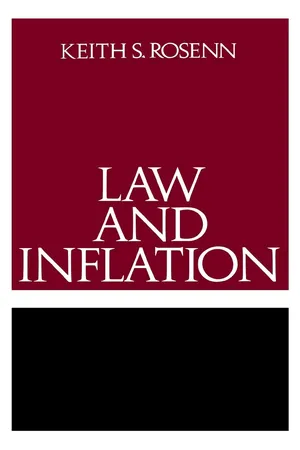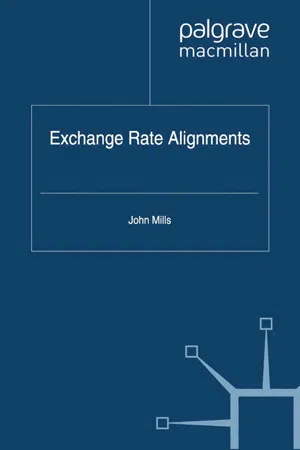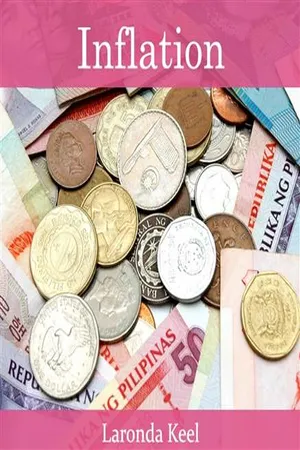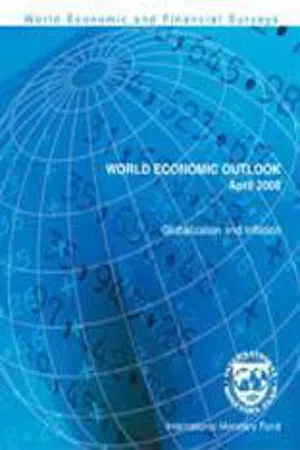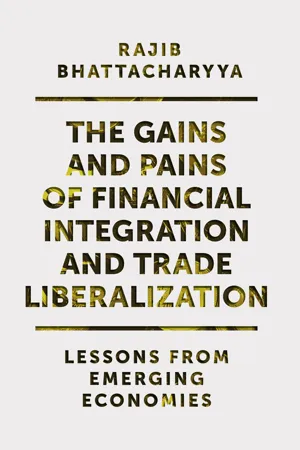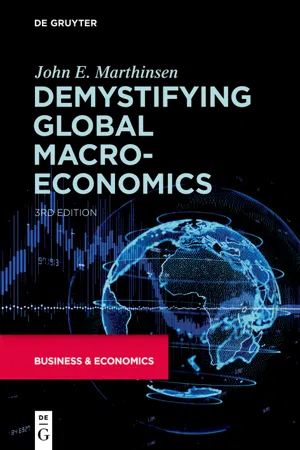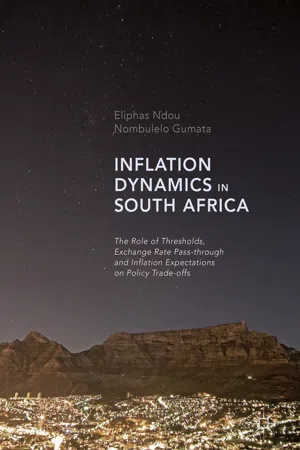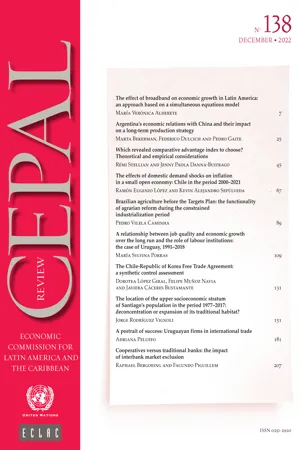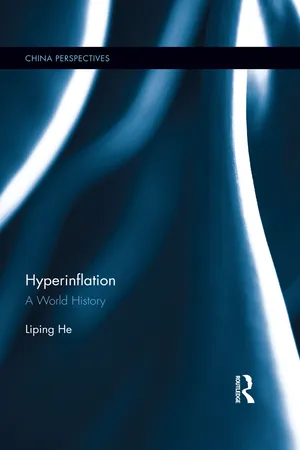Economics
Imported Inflation
Imported inflation refers to the increase in domestic prices of goods and services due to rising costs of imported inputs or finished products. This can occur when a country's currency depreciates, making imports more expensive. Imported inflation can impact a nation's overall price levels and contribute to economic instability.
Written by Perlego with AI-assistance
Related key terms
1 of 5
10 Key excerpts on "Imported Inflation"
- eBook - PDF
Trading Economics
A Guide to Economic Statistics for Practitioners and Students
- Trevor Williams, Victoria Turton(Authors)
- 2014(Publication Date)
- Wiley(Publisher)
(We discuss money supply further in Chapter 5.) Inflation can be thought of as being derived from the costs of produc-ing domestic goods and services and the imported prices of goods and services. In fact the RPI is split into goods prices and services prices, and includes estimates of imported goods. Domestic costs can be mea-sured through the GDP deflator, which does not include imported goods prices. It can be broken down into broad categories such as profits and rents (40 per cent) and wages (about 60 per cent). Import prices are 102 Trading Economics –3 –2 –1 0 1 2 3 4 5 6 7 2012 2010 2008 2006 2004 2002 2000 1998 CPI: Services % yr CPI: Goods Total CPI Figure 4.3 Changes in goods prices explain overall UK price inflation. Source: ONS, McFadden. paid on the basis of the currency that the goods originate from and so the value of the pound will vary between these currencies and so will impact the price of those inputs. These goods can rise or fall in price for other reasons (such as crop failure or a rise in demand or costs), of course, but the change in the pound will also influence domestic price changes. A rise in the pound could push down imported prices; a fall will push prices up. Figure 4.3 shows that goods prices explain why UK consumer price inflation was so low between 1998 and 2007. It seems it was not about monetary policy, but the effect of global economic competition stem-ming from the inclusion of China and India, which drove down internal goods prices. Oil prices played a role, as did services goods prices and a strong sterling exchange rate. The latter, in particular, would have pushed down imported price inflation. But this means that to understand UK inflation you do have to look at the detail of the inflation data, particularly goods price inflation. - eBook - PDF
- Keith S. Rosenn(Author)
- 2015(Publication Date)
- University of Pennsylvania Press(Publisher)
INFLATION'S CAUSES AND CURES The term inflation is often used loosely in English to mean anything from pomposity to increases in money, income, and profits. 1 For the pur-poses of this book, inflation is used to refer either to a sustained rise in an economy's general level of prices or to a corresponding fall in the domestic purchasing power of an economy's currency. This working definition im-plies that inflation is a dynamic process in which the aggregate level of prices is moving upward over time while the purchasing power of money is in corresponding decline. It does not mean that all prices are moving upward uniformly, nor even that all prices are moving upward. It does mean that an economy is undergoing inflation when it presently costs more to purchase a representative sample of goods than it cost in the past. Inflation and its opposite, deflation, describe changes in a nation's internal price levels or its currency's domestic purchasing power. Changes in a currency's external purchasing power occur through adjust-ments in the foreign exchange rate. When the value of country A's cur-rency declines relative to the currency of country B, there has been a devaluation of country A's currency. Correspondingly, there has been an upward revaluation in country B's currency relative to country A. In com-mon parlance references to changes in internal and external purchasing power of a currency are frequently commingled; it is not uncommon to find courts confusingly referring to devaluation when they really mean depreciation in domestic purchasing power. 2 In the long run, countries experiencing inflation rates higher than those of customary trading part-ners will be forced to devalue; however, in the short run, it is frequently possible for countries to maintain the same exchange rate despite sub-stantial domestic inflation, or to devalue by less than the inflation rate differential. - eBook - PDF
- J. Mills(Author)
- 2012(Publication Date)
- Palgrave Macmillan(Publisher)
There is much evidence that the problems with inflation are more diverse and more manageable than is often recognised. Devaluation and the price level Those who believe that exchange-rate changes will affect prices are right in at least one sense. Any parity reduction is bound to exert upward pressure on the costs of all imported goods and services in the devaluing country. While the prices measured in the domestic currency of both imports and exports will almost certainly rise, the tendency for import costs to increase faster than export prices may worsen the terms of trade. In this sense, too, there is a direct cost to the economy. Furthermore, there is no value in a policy of depreciation unless it makes imports more expensive rela- tive to home market production. A major objective has to be to price out some imports by making it relatively cheaper than it was previously to produce locally rather than in other countries. It follows that without price increases for imported goods and serv- ices, there will be no new bias towards production from domestic output. 46 Exchange Rate Alignments The evidence presented in Table 3.1, however, indicates that other factors have to be taken into account. If, as is commonly supposed, only import prices were significant, then the figures in the table would show increasing inflation and declining living standards after a depreciation and not, generally speaking, the opposite. How then are the figures in the table to be explained? The answer is that devaluation’s impact on the price level is more complicated than is often recognised. Many effects are disinflationary rather than the reverse and tend to increase national income rather than reduce it. Obviously, the more exposed an economy is to foreign trade, the greater the immediate impact of exchange-rate changes on living standards and the price level. - No longer available |Learn more
- (Author)
- 2014(Publication Date)
- Orange Apple(Publisher)
____________________ WORLD TECHNOLOGIES ____________________ Chapter- 1 Inflation In economics, inflation is a rise in the general level of prices of goods and services in an economy over a period of time. When the general price level rises, each unit of currency buys fewer goods and services. Consequently, inflation also reflects an erosion in the purchasing power of money – a loss of real value in the internal medium of exchange and unit of account in the economy. A chief measure of price inflation is the inflation rate, the annualized percentage change in a general price index (normally the Consumer Price Index) over time. Inflation's effects on an economy are various and can be simultaneously positive and negative. Negative effects of inflation include a decrease in the real value of money and other monetary items over time, uncertainty over future inflation may discourage investment and savings, and high inflation may lead to shortages of goods if consumers begin hoarding out of concern that prices will increase in the future. Positive effects include ensuring central banks can adjust nominal interest rates (intended to mitigate recessions), and encouraging investment in non-monetary capital projects. Economists generally agree that high rates of inflation and hyperinflation are caused by an excessive growth of the money supply. Views on which factors determine low to moderate rates of inflation are more varied. Low or moderate inflation may be attributed to fluctuations in real demand for goods and services, or changes in available supplies such as during scarcities, as well as to growth in the money supply. However, the consensus view is that a long sustained period of inflation is caused by money supply growing faster than the rate of economic growth. Today, most mainstream economists favor a low steady rate of inflation. - International Monetary Fund. Research Dept.(Author)
- 2005(Publication Date)
- INTERNATIONAL MONETARY FUND(Publisher)
- Over the medium term, the prevailing nominal anchor—such as the central bank’s inflation target—determines inflation. Therefore, the impact of globalization on inflation will be temporary unless it changes the overarching objectives of monetary policy. This is unlikely in industrial countries given the already low single-digit inflation targets (explicit or implicit). In emerging market and developing countries, however, greater openness appears to have been—and is likely to remain—an important factor behind the sustained improvement in inflation.
- The direct effect of globalization on inflation through import prices has in general been small in the industrial economies. That said, when global spare capacity increases—such as during the 1997–98 Asian financial crises and the 2001–02 global slowdown—import price declines have had sizable effects on inflation over one- to two-year periods, shaving more than 1 percentage point off actual inflation in some advanced economies. With low average inflation, such effects are economically significant. This lends support to the view that inflation targets should not be set too close to zero—otherwise shocks of this size could result in periods of deflation.
- Globalization has contributed to reducing the sensitivity of inflation to domestic capacity constraints in advanced economies over the past couple of decades—for example, through the impact on the labor markets and wages. As global economic developments have become increasingly important for domestic inflation, they will require closer monitoring by monetary policymakers in the years ahead.
- Globalization has had a significant effect on relative prices in industrial economies. Sectors that have become more exposed to foreign competition have seen the largest relative price declines in recent years. Nevertheless, globalization is not the only factor driving relative price changes. While openness has been important, particularly in low-tech and low-skill sectors, productivity growth has also contributed significantly to relative price changes, particularly in the high-tech manufacturing and services sectors. Indeed, while price increases in the manufacturing sector have consistently been below those in services, the decline in inflation in some services sectors since the mid-1990s has been more pronounced, contributing as much to the decline in overall producer price inflation as the manufacturing sector.
- eBook - ePub
The Gains and Pains of Financial Integration and Trade Liberalization
Lessons from Emerging Economies
- Rajib Bhattacharyya(Author)
- 2019(Publication Date)
- Emerald Publishing Limited(Publisher)
Chapter 14
Imported Inflation through Exchange Rate in India Hiranya Lahiri AbstractOne major source of inflation in India is her import of intermediate inputs. In the modern globalized world, where India is deeply integrated with the world economy, exchange rate affects inflation through various channels. This chapter attempts to gauge the extent of exchange rate pass through to inflation. Using the co-integration framework, this chapter finds considerable evidence of Imported Inflation in the long run, almost 40%–74% for CPI-IW. At the same time, we also discern evidence of short-run price stickiness of CPI-IW. However, for CPI-AL, the extent of pass-through is a meager 14%. This is due to the fact that CPI-IW gives more weightage to imported components while CPI-AL gives more weight to food and clothing, which are mainly domestically produced.Keywords: Exchange rate; inflation; co integration; error correction model; exchange rate pass through; intermediate goodsJEL Classification: C22; E00; F41Introduction
India is highly integrated with the world economy. As a result, imports figure out to be a substantive component of GDP, of which import of intermediate inputs comprise a significant part. Intermediate inputs comprise of items like oil, metals, gems and jeweleries, electrical components, etc. As a result, a rise in price of these items (particularly through a rise in the exchange rate) comprises a significant component of inflation. In modern literature, this phenomenon is often alluded to as exchange rate pass-through. That is, exchange rate pass-through (ERPT) measures how much impact an increase in exchange rate has on the price level.The effect of exchange rate on price of output depends on how products are priced; whether they are priced in domestic currency or in foreign currency? If a product is priced in foreign currency, exchange rate pass-through would be complete. That is, 1% depreciation would result in 1% increase in product price. If, however, products are priced in local currency, incomplete pass-through will occur. This is because domestic producers are plagued with price stickiness, and hence, they are unable to fully pass it on to the consumers in the short run. In the long run, the producers are able to pass on some of the increase in exchange rate to product prices. - eBook - PDF
- John E. Marthinsen(Author)
- 2020(Publication Date)
- De Gruyter(Publisher)
Adams, who said, “ There are plenty of good five-cent cigars in the country. The trouble is they cost a quarter. What this country needs is a good five-cent nickel. ” Inflation is like an acid that erodes the purchasing power of a nation ’ s cur-rency. The higher the inflation, the greater the erosion. Consider the U.S. dollar ’ s loss of purchasing power between 1913 and 2019. What do you think it cost in 2019 for a basket of goods and services worth $100 in 1913? You might be 1 ” Where ’ s the beef? ” has become a motto in the United States and Canada, since it was first introduced in 1984, in a Wendy ’ s restaurant commercial. Since then, it has been used by poli-ticians and others when questioning the value or substance of an idea or product. https://doi.org/10.1515/9781547401437-004 surprised to learn that, due to inflation, a basket of products costing $100 in 1913 cost more than $2,600 in 2019! 2 Inflation is defined as a sustained increase in the average price level. When the average price level falls for a sustained period, it is called deflation , and when prices get out of hand and rise very quickly, it is called hyperinflation . One of the most common, but unofficial, definitions is hyperinflation occurs when a nation ’ s prices increase above 50% per month for a sustained period . 3 If the price of every good and service in a nation rose by the same percent-age — say, 3% — then the inflation rate would be easy to calculate, but such ho-mogeneous changes in prices never occur. Prices change at different rates. Some rise rapidly, others slowly, some stay the same, and others even fall. Much of the relative difference depends on market factors, such as the level of demand, costs, and competitive structure of an industry. It is for this reason that the inflation rate is calculated as a weighted average of percentage price changes, with the weights reflecting the relative importance of each product being considered. - eBook - PDF
Inflation Dynamics in South Africa
The Role of Thresholds, Exchange Rate Pass-through and Inflation Expectations on Policy Trade-offs
- Eliphas Ndou, Nombulelo Gumata(Authors)
- 2017(Publication Date)
- Palgrave Macmillan(Publisher)
In Fig. 15.5 (a) and (b), it can be seen that oil and other commodity price changes amplify the responses of domestic inflation to positive global import growth shocks. Furthermore, in Fig. 15.5(c) the amplification on inflation in the presence of high oil prices contributes 0.27 percentage points to inflation compared to 0.18 percentage points in the presence of commodity prices at peak. At the same time Fig. 15.6(a) shows that when inflation expec- tations are also included and are elevated, they propagate the impact of the exchange rate depreciation and import growth shocks on inflation by a cumulative 1.6 percentage points in 35 months. This means that inflation expectations affect inflation indirectly through amplification ability. Indeed, policymakers should anchor inflation expectations as they also play a meaningful role in propagating inflationary responses to rand depreciation and inflationary shocks. Moreover, Fig. 15.7 shows that since 2015 the world import growth shock has exerted downward pressure on the actual inflation rate. The counterfactual inflation exceeded actual inflation. A similar trend is observed with respect to the contributions of import growth price pressures due to advanced and emerging and developing economies. 15 Does World Import Growth Amplify Domestic Inflation. . . 221 Fig. 15.5 Amplification of inflation responses by oil and commodity prices. Source: Authors’ calculations 222 Inflation Dynamics in South Africa Fig. 15.6 Inflation responses to rand depreciation and the propagation role of break-even inflation rates. Source: Authors’ calculations 15 Does World Import Growth Amplify Domestic Inflation. . . 223 However, it is also evident that emerging and developing economies’ import growth has persistently exerted downward pressure on domestic inflation since 2013. The results suggest that indeed subpar global growth has resulted in muted inflationary pressures and has played a meaningful role in keeping inflation within the target band. - No longer available |Learn more
- Economic Commission for Latin America and the Caribbean(Author)
- 2022(Publication Date)
- United Nations Publications(Publisher)
Our aim is to take advantage of this gigantic experiment to evaluate the relevance of demand policies in an economy like Chile’s under crisis conditions. 1 This paper adopts an eclectic position which allows for the possibility that domestic demand factors may affect inflation in confluence with external inflation. The determinants of changes in domestic inflation are specified as changes in inflation abroad, movements in the nominal exchange rate and internal demand factors. Since the exchange rate is likely to be affected by demand factors, we provide for simultaneous determination of inflation and the exchange rate. II. The model We start with a basic price equation which we subsequently modify to deal with several potential econometric issues and to include some additional dynamic considerations: = (1) where p t is the level of the domestic price index in month t, A is a constant, P t is the foreign price index, E t is the nominal exchange rate, D t is the level of internal demand, α,β,γ are parameters and μ t is the statistical error. We first express equation (1) in logarithms. Additionally, to account for the possibility of unit roots, we estimate this equation using log first differences: ∆lnp t = α∆lnP t + β∆lnE t + γ∆lnD t + ∆μ t (2) 1 Chile is a small economy that is extremely open to both trade and capital flows. This would suggest in principle that if the purchasing power parity (PPP) hypothesis holds even in its weakest versions, such as relative parity, or even if a quasi-PPP condition prevails (Hegwood and Papell, 1998), the inflationary effect of demand policies, such as those implemented in 2020 and 2021, should be limited. This in turn would imply that domestic demand stimuli should be effective in promoting production and employment and possibly investment, with only a small inflationary effect. - eBook - PDF
- He Liping(Author)
- 2017(Publication Date)
- Routledge(Publisher)
But, hyperinflation can lead to an outcome where people even abandon the use of national currency in domestic transactions, i.e., the money loses its other two functions as well. Econo-mists nowadays refer to this situation as “ dollarization ” – the widespread use of Introduction 5 foreign money in domestic transactions. When the situation is not recognized by the government concerned, it is de facto dollarization. And when a government formally endorses a foreign currency as legal tender in its jurisdiction, it is de jure dollarization. Partial dollarization means that domestic and foreign currencies coexist in domestic transactions, and this most probably suggests that the domes-tic money has lost its function as a store of value. What causes hyperinflation? The causes of hyperinflation are easily confused with those of inflation. With regard to the latter, the following are often regarded as necessary candidate factors: • Shortages : Excess demand caused by either a demand or supply shock such as a sudden drop in output due to a natural disaster; • Balance of payments shocks : For example, a sudden rise in international oil prices (terms of trade shock); overvaluation of domestic currency leading to deterioration of the currency account balance; or unsustainable accumulation of foreign debt; • Government budget deficit : Such as a sudden loss of revenue or an irresistible increase in fiscal spending; • Expansionary monetary policy : Monetary authorities in a country adopt a policy of continually increasing money supply and pushing down interest rates in real terms; • Paper currency system : Governments with paper money systems are con-stantly tempted to resort to an inflationary policy to finance budgetary needs as and when necessary or desirable. Modern periods of inflation have been closely related to these factors. When infla-tion occurs in a country over a period of time, people can often identify at least one of the five factors.
Index pages curate the most relevant extracts from our library of academic textbooks. They’ve been created using an in-house natural language model (NLM), each adding context and meaning to key research topics.
